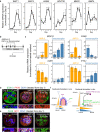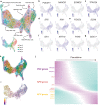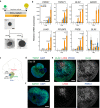In vitro induction of patterned branchial arch-like aggregate from human pluripotent stem cells
- PMID: 38355589
- PMCID: PMC10867012
- DOI: 10.1038/s41467-024-45285-0
In vitro induction of patterned branchial arch-like aggregate from human pluripotent stem cells
Abstract
Early patterning of neural crest cells (NCCs) in the craniofacial primordium is important for subsequent development of proper craniofacial structures. However, because of the complexity of the environment of developing tissues, surveying the early specification and patterning of NCCs is difficult. In this study, we develop a simplified in vitro 3D model using human pluripotent stem cells to analyze the early stages of facial development. In this model, cranial NCC-like cells spontaneously differentiate from neural plate border-like cells into maxillary arch-like mesenchyme after a long-term culture. Upon the addition of EDN1 and BMP4, these aggregates are converted into a mandibular arch-like state. Furthermore, temporary treatment with EDN1 and BMP4 induces the formation of spatially separated domains expressing mandibular and maxillary arch markers within a single aggregate. These results suggest that this in vitro model is useful for determining the mechanisms underlying cell fate specification and patterning during early facial development.
© 2024. The Author(s).
Conflict of interest statement
The authors declare no competing interests.
Figures









Similar articles
-
Ectodermal-derived Endothelin1 is required for patterning the distal and intermediate domains of the mouse mandibular arch.Dev Biol. 2012 Nov 1;371(1):47-56. doi: 10.1016/j.ydbio.2012.08.003. Epub 2012 Aug 11. Dev Biol. 2012. PMID: 22902530 Free PMC article.
-
Neural Crest Cell Models of Development and Toxicity: Cytotoxicity Assay Using Human Pluripotent Stem Cell-Derived Cranial Neural Crest Cell Model.Methods Mol Biol. 2019;1965:35-48. doi: 10.1007/978-1-4939-9182-2_4. Methods Mol Biol. 2019. PMID: 31069667
-
Endothelin regulates neural crest deployment and fate to form great vessels through Dlx5/Dlx6-independent mechanisms.Mech Dev. 2013 Nov-Dec;130(11-12):553-66. doi: 10.1016/j.mod.2013.07.005. Epub 2013 Aug 8. Mech Dev. 2013. PMID: 23933587
-
[Phenotypic plasticity of neural crest-derived melanocytes and Schwann cells].Biol Aujourdhui. 2011;205(1):53-61. doi: 10.1051/jbio/2011008. Epub 2011 Apr 19. Biol Aujourdhui. 2011. PMID: 21501576 Review. French.
-
The stemness of neural crest cells and their derivatives.Birth Defects Res C Embryo Today. 2014 Sep;102(3):251-62. doi: 10.1002/bdrc.21079. Epub 2014 Sep 15. Birth Defects Res C Embryo Today. 2014. PMID: 25219876 Review.
Cited by
-
Stepwise strategy for generating human trophoblast stem-like cells from embryonic stem cells reveals specific role of TFAP2C in acquiring self-renewability.Sci Rep. 2025 May 30;15(1):19040. doi: 10.1038/s41598-025-03830-x. Sci Rep. 2025. PMID: 40447714 Free PMC article.
-
Jawbone-like organoids generated from human pluripotent stem cells.Nat Biomed Eng. 2025 Jul 2. doi: 10.1038/s41551-025-01419-3. Online ahead of print. Nat Biomed Eng. 2025. PMID: 40603745
References
MeSH terms
Grants and funding
LinkOut - more resources
Full Text Sources
Molecular Biology Databases

